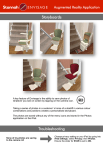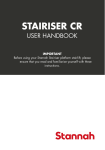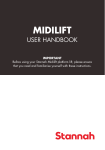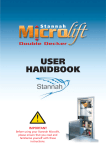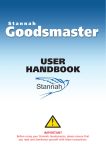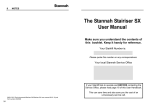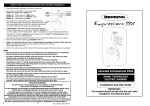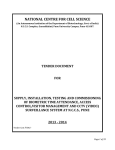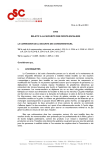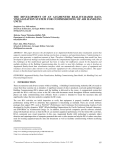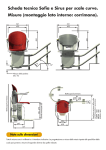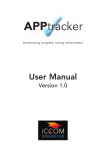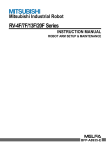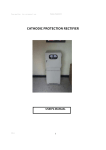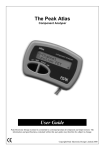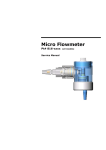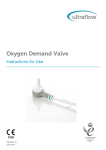Download Stannah Stairiser SR Feb 2014 - Stannah Technical Information
Transcript
STAIRISER SR USER HANDBOOK IMPORTANT Before using your Stannah Stairiser platform stairlift, please ensure that you read and familiarise yourself with these instructions. CONTENTS Introduction 3 Intended Use 5 General Layout 6 Operating Instructions 10 Emergency Operations 20 General Stairlift Care Procedures 23 Trouble Shooting Guide 24 Notes 27 Guarantee 30 Service branch contact details 31 NOTE: Whilst every lift has been made to ensure the clarity and accuracy of this hand book, we cannot be held responsible for any damage or injury resulting in negligence or misuse of this stairlift. 2 INTRODUCTION This users handbook is to help provide an understanding of correct and safe use of the Stannah Stairiser SR. It is important that you arrange for the lift to receive regular inspection and servicing by a competent person at intervals not exceeding six months, after the 12 months guarantee period. Failure to ensure servicing is carried out could lead to unreliable or unsafe operation. For all enquiries regarding servicing, please contact your local Stannah Service Branch details in the back of this User Handbook). A Service Log Card will be completed after each service visit. For your records: 3 KEY SYMBOLS The following signs are used as a guide throughout the handbook: Pay attention to all paragraphs marked with this sign. These paragraphs contain important hints that will insure flawless operation of the lift. WARNING! Important safety advice! Observing these instructions greatly reduces the possibility of hazardous situations. Pay attention! Do not execute the actions marked with this sign! 4 INTENDED USE Load Capacity The maximum capacity of the lift is indicated on the front face of the carriage. Safe working load: 225 kg wheelchair and occupant. • • • • • • • • This stairlift SR must only be used for the transport of persons in wheelchairs or sitting on the optional fold down seat. Never use the stairlift in the standing position. The stairlift is not designed for carrying goods or animals of any kind. The exceptional use by trained guide dogs is permitted. Remove key switch from both the lift and the platform after use. Do not let children play on the lift. Do not exceed the maximum platform load or maximum wheelchair size. Keep hands and fingers away from the back of the carriage! Passengers must remain in the wheelchair or seat while the lift is operating. Persons walking up or down the stairs while the lift is being operated must avoid contact with the platform. Platform users should take into consideration that the platform needs more space in a bend than on a straight railway. Therefore, before moving, look to see if anyone is using the stairs or if there are any obstacles. Emergency Stop An emergency stop is fitted on the carriage. In case of emergency press the red STOPswitch and the lift will stop immediately. To release the STOP-switch, it will be necessary to press it once more or to turn it clockwise. We recommend preventive checks are carried out on the lift. Regular servicing of your stairlift will ensure safe operation for a long time. Any abnormal operation of the lift should be reported to the service office. In the case of irregularities such as vibrations or abnormal noise emissions, do not use the lift; call your Service Branch. 5 G E N E R A L L AYO U T 4 1 9 2 4 7 6 8 5 3 1. 2. 3. 4. 5. 6. 7. 8. 9. 3 Key switch Emergency STOP Ramps Barriers, liftable Carriage cover Directional control Folding seat (option) Main control button at the carriage side Green lamp Drive (behind the carriage sidewall) 1. 2. 3. 4. 5. 6 Gear box Motor Hand wheel Hand lever for break release Lower guide rail (=toothed rack) 8 G E N E R A L L AYO U T Technical Details X = Standard Performance O = Optional Performance Feature Detail Railway Gradients 15...45° X Length up to 15 m X Length over 15 m O Speed appr. 0,1 m/s X Power 0,5 kW X Voltage 24V DC X 1 x 230 V for recharger X Position of drive Inside carriage X Site indoors X Tolerable temperatures 0°C to +40°C X Environment Only at dry areas X Carriage model Platform for wheelchairs X Platform / folding seat O standard 700 x 750 mm X standard 750 x 850 mm standard 800 x 900 mm standard 800 x 1000 mm Optional size X X X O standard 150 kg X optional 225 kg O Surface protection of lift Powder coated X Drive rails Stainless steel X Noise < 70 dB(A) X Platform size Load capacity 7 G E N E R A L L AYO U T 1. 2. 3. 4. 5. 6. 7. 8. 9. Wall control Recharger Carriage Upper stop position Lower stop position Intermediate stop position Upper railway tube Lower railway tube Overspeed governor Battery Charge System The motor of the stairlift is powered by batteries, which are reloaded by a recharger. The recharging occurs in the upper and lower stop positions by recharge contacts, therefore, if the lift is not in use it is important that it is parked in the stop positions. An acoustic warning signal sounds if the stairlift is parked outside of the stop position. The Beeper If the platform is not in the stop position within 5 minutes after use, the beeper will sound every second. If so, please bring the platform to the stop position. If the lift is parked in the stop position and the beeper still gives signals, this suggests a problem with the recharger. Please turn off the lift mains power switch and check if there are building power outs or if a fuse is not working. If any such errors are corrected and the beeper is still giving signals please contact your Service Branch. If the battery voltage is too weak for normal operation then the beeper will sound every 2.5 seconds. Please bring the carriage in the stop position to recharge the batteries. If the beeper does not stop after recharging, then the batteries may need to be changed. Even with weak batteries the control system is programmed to ensure the carriage always reaches the lower position with the remaining battery voltage. 8 G E N E R A L L AYO U T Landing Controls The Stairiser SR is equipped with landing controls that communicate via radio with the carriage. With these controls, the lift can be called and sent when the platform is closed. In the case of automatic platform the platform also can be opened and closed with the controls. The controls are supplied by one 9volt battery. A connection cable to a constant power supply is possible. The life-time of the battery is approximately one year. In general, the battery is usually changed during the service. The functionality of the battery can be checked as follows: • • • In each wall control, a green lamp is installed. This lamp will begin to flash if the key switch of the control is switched on and control buttons are depressed. If the lamp does not flash, a change of the batteries will be necessary. 9 O P E R AT I N G I N S T R U C T I O N S The Stairiser SR is easy to use. The technical control of the lift is entirely adapted to the abilities of physically handicapped persons. Please refer to the general layout on the previous pages for a better understanding of the stairlift. There are two types of platform operation: manual or automatic. Manual platforms must be opened by hand; the barriers have to be lifted as well. Automatic platforms perform these functions automatically. Main Power Switch The main power switch is located at the left side wall of the carriage. For use of the lift, first turn on the main power switch. By switching off the main power switch, the lift cannot be used (also disables the wall controls). If the main power switch and the key switch are switched on, the green lamp on top of the carriage is illuminated. Main switch The main power switch connects the stairlift to the power supply system. For use of the lift, first turn on the main power switch. By switching off the main power switch, the stairlift can be isolated from the circuit. It is necessary to switch off the main power switch while repairs are done to the stairlift, especially in the drive box. Before operating the lift, ensure that the platform area is clear. 10 O P E R AT I N G I N S T R U C T I O N S MANUAL PLATFORM OPERATING INSTRUCTIONS The following comments are valid only for carriages equipped with a manual platform: Calling of the platform Most lifts are equipped with wall controls that allow control from either ends of the staircase. Landing controls are fitted in the area of landing positions. 1. 2. 3. 4. 5. Battery behind cover “Up”-Button “Down”-Button Key switch Green light 1 2 3 4 5 If the platform is not on the level on which you want to move onto the platform, you can call the platform by using the wall controls: Switch on the wall control by inserting and turning the key. Press the “Up” or “Down” button and the platform moves in the direction requested as long as you press and hold the button. The green light will start to flash. Wall controls only control the lift when the platform is folded up. Always make sure that you have a clear view of the path of the lift when moving the carriage on the stairs. Stop the lift immediately if there is an obstacle in the way. Should the carriage not stop after releasing the drive button, use the key switch to stop the lift. Unfolding the Platform In order to enter the lift the platform or the seat has to be opened. When opening, the other controls are automatically switched off so that no other person can move the lift at the same time and a safe passage onto the lift is possible. 11 O P E R AT I N G I N S T R U C T I O N S Driving/Moving onto the Platform When the unlocked barrier is opened, the ramp will automatically fold down. The barrier down to the staircase is always locked (except at the lower stop position = special customer request). Image 1 Always face the direction of travel, and use the wheelchair brake for safety. Close the barrier when on the platform (image 2). When the barrier is closed the ramps will automatically lift up. This is an additional safety feature that secures the wheelchair. Travelling The carriage controls consist of a directional control on a spiral cable, a key switch and an emergency stop. The platform contains a directional control, connected to a spiral cable, a key switch, an emergency stop and a green control lamp at the side of the platform. On some models there may be a key switch at the side of the platform. 1. 2. 3. 4. 5. 6. Key switch Emergency Stop Barriers Carriage cover Drive controls (Up/down) Green lamp Open barrier and enter platform Close barrier Image 2 Use wheelchair brakes 3 1 6 2 3 5 4 12 O P E R AT I N G I N S T R U C T I O N S When the passenger has moved onto the platform in accordance with the “Driving/ Moving onto the platform” instructions, the platform control must be switched on. • • Put in the key and turn it into “ON” position. The green lamp will start to glow. Now the carriage can be set in motion by pressing the “up” or “down” directional controls. The carriage stops at all stop positions (upper-, lower-, intermediate stop) automatically. When the directional control remains pressed during an intermediate stop, the carriage will stop for about two seconds; then the carriage will continue travelling towards the planned stop position. Turn key “ON” Watch the path of the lift on the stairs! Always watch the path of the lift on the stairs! If there is danger that the platform will hit an obstacle, stop the lift by releasing the control button. The lift will automatically stop when it reaches your destination. If there is an intermediate stop, the lift will continue to travel after a pause of 2 seconds if the directional control button remains pressed. The carriage will stop if obstacles are encountered! As a safety measure, the lift is equipped with an emergency stop (red button on the carriage). In the unlikely event that the stairlift does not stop when the directional control button is released, press the emergency stop button, a self-locking button, and the lift will stop immediately. To unlock the emergency stop button, press it once more or turn it clockwise. 13 O P E R AT I N G I N S T R U C T I O N S Leaving the Platform The stairlift has been designed to stop in the correct position at each landing. Release the directional control when the carriage has reached the desired stop position. Switch off the platform control by turning the key into “OFF” position. Take out the key (image 3). Lift the unlocked barrier (image 3) and the ramps will automatically descend to the turn down position. Now you can leave the platform. Image 3 Turn off key switch and lift up the barrier To avoid unauthorised use of the stairlift, always switch it off with the key when not in use (image 3). After leaving the stairlift, lift down the barriers and fold up the platform. By folding up the platform the wall controls (landing controls) will be re-activated. The carriage can be sent to the desired parking position (image 4). If there is an acoustic signal 5 seconds after releasing the directional control button then the lift is probably not in the exact recharging position. Please reactivate the drive button to send the lift in the final position (image 5). Image 4 Leave the platform Image 5 Platform closed 14 O P E R AT I N G I N S T R U C T I O N S AUTOMATIC PLATFORM OPERATING INSTRUCTIONS The following comments are valid only for carriages equipped with automatic platforms and barriers: Wall Controls All automatic platform lifts are equipped with wall controls which allow control from either end of the staircase and allow to fold down or up the platform. 1 Landing controls are fitted in the area of landing positions. 2 3 1. 2. 3. 4. 5. 6. 7. Emergency switch, (if existing) “UP”-Button “DOWN”-Button “Close”-Button “Open”-Button Key switch Green light 4 5 If the platform is not on the level on you require, call the platform by using the wall controls: Switch on the wall control by inserting and turning the key. Press the “Up” or “Down”-Button and the platform moves into the direction as long as you hold the button. The green light starts to flash! The carriage travels as long as you keep the directional button on the wall control depressed. Wall controls only control the lift when the platform is folded up. The carriage stops automatically at the stop position. To use the lift fold down the platform by using the “Open”-Button. Press the button as long as it takes that the platform is in horizontal position and the barrier has opened completely. Simultaneously, the ramps turn down to the correct position enabling safe driving/moving onto the platform. When the platform is folded down, all controls other than the platform control lose their functionality. This allows safe movement onto the platform. 15 O P E R AT I N G I N S T R U C T I O N S Driving/Moving onto the Platform You can move onto the platform after you have opened the platform and the barrier in accordance with the former chapter. Always face the direction of travel and use the wheelchair brake for safety. Press the button for “open” on the wall control as long as the platform is horizontally positioned and the barrier is opened. When opening, the other controls are automatically disabled so that no other person can move the lift at the same time. Image 6 Open platform & barrier Always keep a clear view of the path of the lift on the stairs (image 6). If there is any danger, immediately stop the movement of the lift by releasing the pressed button. Switch off the platform control by turning the key into “OFF” position. Take out the key. When the unlocked barrier is opened, the ramp will automatically fold down (image 7). The barrier down to the staircase is always locked (excepting at the lower stop position = special customer request). Always face the direction of travel, and use the wheelchair brake for safety. Close the barrier when on the platform. (image 8). When the barrier is closed the ramps will automatically lift up. This is an additional safety feature that secures the wheelchair. 16 Image 7 Open barrier &enter platform Image 8 Close barrier Use wheelchair brakes O P E R AT I N G I N S T R U C T I O N S Travelling The carriage control on the sidewall consists of a directional control on spiral cable, a key switch and an emergency stop (image 9). Image 9 3 6 1 2 The platform contains a directional control, connected to a spiral cable, a key switch, an emergency stop and a green control lamp at the side of the platform. On some models there may also be a key switch at the side of the platform. 1. 2. 3. 4. 5. 6. Key switch Emergency Stop Barriers Carriage cover Drive controls (Up/down) Green lamp When the passenger has moved onto the platform in accordance with the “Driving/ Moving onto the platform” instructions, the platform control must be switched on. 3 Put in the key and turn it into “ON” position. The green lamp will start to glow (image 10). 5 4 3 Image 10 Switch on the key switch 17 O P E R AT I N G I N S T R U C T I O N S Always maintain a clear view of the lift on the stairs! If there is danger, stop the lift by releasing the control button. The carriage stops when the ramps or any other safety pad travels against obstacles (image 11). The lift will stop automatically when it reaches it’s destination. If there is an intermediate stop, the lift will continues after a pause of 2 seconds if the directional control button remains pressed. After the lift stopped the drive button must be kept pressed until the barrier opens. If you don’t want to stop at an intermediate stop position briefly release the drive button and activate it again in the same direction. The lift will briefly stop and then continue to drive in the desired direction. Image 11 Switch on the key switch Watch the path of the lift on the stairs! As a safety measure, the lift is equipped with an emergency stop (red button on the control). Press the emergency stop button and the lift will stop immediately. To unlock the emergency stop button, press it once more or turn it clockwise. 18 O P E R AT I N G I N S T R U C T I O N S Leaving the Platform The stairlift has been designed to stop in the correct position at each station. Keep the directional control button pressed until the barrier has folded up and the ramp has folded down to the correct position (image 12). When the barrier is fully opened (and the ramps are fully folded down), release the directional control. Image 12 Lift up barrier arm and switch off the key switch Switch off the platform control by turning the key into “OFF” position. Take out the key. Now you can leave the platform (image 13). Image 13 After leaving the platform you have to switch on the wall control by putting in and turning the key. Press the “Up”-Button and the platform folds up as long as you hold the button. Press the “Up”Button until the platform is folded up completely. Now switch off the wall control by turning back the key to position “OFF”. Take out the key before travelling away from the stairlift. Leave platform By folding up the platform the wall controls (landing controls) will be re-activated. The carriage can now be sent to the desired parking position for recharging (image 14). Image 14 To avoid unauthorised use of the stairlift, always switch it off with the key when not in use. Close platform 19 E M E R G E N C Y O P E R AT I O N If it necessary to evacuate a user from the lift due to either lift or power failure, the procedures described here should be followed. A different process is needed, dependant on where the platform has stopped: Case 1: 1: The occupied platform is near a stop position Notice: The main power switch is on the side of the platform wall. Main power switch 1. Switch of main power switch 2. Insert hand wheel 3. Tighten the hand lever for break release and turn the hand wheel until the next station has been reached. 4. At every landing the barrier can be opened manually at the side where leaving the platform is desired. 5. Now the wheelchair driver can leave the platform. 6. If using a manual platform, close the platform as usual. That means: First close the barriers and then fold up the platform. 7. If using an automatic platform, first fold down the barrier to the closed position. Then the platform can be closed without any problem. The platform must be locked with the padlock on the carriage. 8. Call your service team! Attention: Rescue of passengers can only be done by authorised people Insert hand wheel Break release Hand wheel and break lever Attention: Rescue of passengers can only be done by authorised people 20 E M E R G E N C Y O P E R AT I O N Case 2: The occupied platform is not close to a stop position For the rescue of the passenger two persons are needed! If there is only one person available, it is necessary to wind the carriage into the next station (see case 1). Main power switch Notice: The main power switch is on the side of the platform wall. 1. Switch of main power switch 2. Insert hand wheel 3. Tighten the hand lever for break release and turn the hand wheel until the position has been reached where the distance between the rail and the steps are minimal. 4. Emergency unclamping of the barrier: In order to open the barrier when not in a station, please carry out the following instructions. It is only permitted to open the barrier up to the stairs (see page 18). Otherwise one could face the danger of falling or rolling down. 5. Detailed instruction for the emergency unclamping is given on page 23. 6. The wheelchair driver can now be lifted down from the platform. 7. If using a manual platform, close the platform as usual. That means: First close the barriers and then fold up the platform. 8. If using an automatic platform, first fold down the barrier to the closed position. Now the platform can be closed without any problem. The platform must be locked with the padlock on the carriage. 9. Call your service team! Insert hand wheel Break release Ope n barrier up to the stairs Hand wheel & break lever Always rescue with two people assisting 21 E M E R G E N C Y O P E R AT I O N Emergency Unclamping of Barrier For unclamping a barrier somewhere out of a station, press the lever located at the back of the carriage. The position of this lever is shown in detail on the drawing beside. Attention: The red, marked lever must be pressed for unlocking the barrier up to the stairs. Do not press the unmarked lever, in this case the downside barrier would be opened and there is danger of falling down the stairs! Press and hold this lever and open the barrier with an abrupt pull! Levers for unclamping are at the backside of the platform The lever for the emergency unclamping of the barrier (up to the stairs) is marked RED ! 22 G E N E R A L S TA I R L I F T C A R E It is absolutely necessary that the lift is serviced regularly to ensure safe operation. Stannah Lift Services Ltd offers a special maintenance programme adapted to the frequency of use. CheckCheck-Up & Care Check the following points at regular intervals, say once a week. 1. The carriage must not start travelling until the barrier is completely folded down and the ramp is turned down to the appropriate position. 2. It should be impossible to fold up the barriers while travelling. This should be tested between two stop positions. 3. Check if the barriers are closed and if the ramps are folded up while travelling. If the ramps run against an obstacle or if the user presses down the ramp, the carriage will have to stop immediately. The linkage between barriers and ramps must be in faultless condition (safely screwed on, no damage of the rope). 4. The carriage has to stop automatically at every stop position. 5. The carriage must stop when the directional control is released. The brake has to be activated immediately. 6. The emergency stop button must put the whole stairlift out of operation. 7. If an emergency call system is in place, ensure that it works. 8. Remove dust and dirt from the tubes of the railway at regular intervals. 9. Keep the access free to the drive and to the main power switch. For cleaning the stairlift use a soft cloth and soapy water. All further maintenance work is only allowed to be done by Stannah Lift Services ltd or any of our authorised partners. DISMANTLING/REMOVAL OF STAIRLIFT ! You should not attempt to dismantle any parts of the stairlift. Such work should be entrusted only to competent personnel with relevant expert knowledge and training. Advise any malfunctions of the lift operation to the Stannah Service Office or to our service personnel when they are next in attendance. 23 T R O U B L E S H O OT I N G G U I D E For safety reasons, the Stairiser SR is equipped with several electrical and mechanical locking devices. The stairlift will not work if any of these devices are tripped or if the order of events is incorrect. By following the instructions provided in the ensuing paragraphs, the user will be able to determine the reason for breakdown. You must not manipulate, modify or remove any safety feature of the stairlift. Work through the following instructions paragraph-by-paragraph. Do not skip any part! Be sure that the landing controls are deactivated whenever the platform is folded down. Before trouble shooting, pay attention to the following: When a landing control is activated, it automatically deactivates all other wall controls, i.e., the complete lift can only be controlled by one control at a time. If a wall control activates the parked lift, no other control can signal the lift as long as this wall control is active. Please check that the main power switch, located at the left side of the drive box, is activated. The green lamp on the platform should now glow. Please check if the fuses in the distribution box of your house/business are working and turned on. If the lift is giving acoustic signals please check the batteries as described in the section “battery charge system”. If you call the service please note your lift number. This you find at the front of the carriage under the “serial number”. It is the easiest way to identify your lift to give fast and efficient advice. 24 T R O U B L E S H O OT I N G G U I D E T h e la n d in g c o n tr o l h a s b e e n tu r n e d o n w ith th e k e y , th e d ir e c tio n a l c o n tr o l is p r e s s e d , b u t th e c a r r ia g e d o e s n o t m o v e . C lo s e th e p la tf o r m ! No Is th e p la tf o r m c lo s e d ? Yes Yes Is the green lamp at the wall control glowing when calling the lift? No No Yes D o e s th e s ta ir lif t o p e r a te ? C h e c k if th e r a m p s a n d th e s a f e ty p a d ( if e x is tin g ) o n th e u n d e r s id e o f th e p la tf o r m a r e f r e e o f c o n ta c t w ith o b s ta c le s . No C h e c k if a ll e m e r g e n c y s to p s ( o n th e c a r r ia g e a n d o n th e la n d in g c o n tr o ls ) a r e u n lo c k e d . Y es T r y to c o n tr o l th e s ta ir lif t f r o m th e la n d in g c o n tr o l n e a r e s t to th e c a r r ia g e . D o e s th e s ta ir lif t o p e r a te ? Y es No O p e n th e p la tf o r m a n d c lo s e th e b a r r ie r s . C lo s e th e p la tf o r m . T r y to c o n tr o l th e s ta ir lif t f r o m th e d ir e c tio n a l c o n tr o l o n th e c a r r ia g e . D o e s th e s ta ir lif t o p e r a te ? C h e c k if th e p la tf o r m is c lo s e d c o m p le te ly a n d if th e r e is n o o b je c t ja m e d b e tw e e n th e p la tfo r m a n d th e c a r r ia g e Yes No c h e c k th e fu s e s in th e c o n tr o lb o x a s d e s c r ib e d in th is h a n d b o o k No Yes D o e s th e s ta ir lif t o p e r a te ? D o e s th e s ta ir lif t o p e r a te ? Y es No OK C o n ta c t o u r s e r vic e te a m a n d a s k f o r a d v ic e . P r o b a b ly th e p la tf o r m h a s n o t b e e n c lo s e d c o m p le te ly. 25 T R O U B L E S H O OT I N G G U I D E The carriage start travelling after pressing the directional control on the platform and stops after about 10 cm. Please close the barriers! No Are all barriers closed? Yes Does the stairlift operate? Check if the ramps and the safety pad (if existing on the underside of the platform) are free of contact with obstacles. No Yes W hen all barriers and ramps are free of contact with obstacles, please close the barriers, also when the automatic platform is used, once more by pressing it down manually. Try to start travelling once again. Yes Does the stairlift operate? No Carry out the instructions given in the paragraph "Rescue of passengers" OK 26 Contact our service team and ask for advice. N OT E S 27 N OT E S 28 N OT E S 29 G UA R A N T E E Your Stannah Guarantee Stannah Lifts Ltd are proud to have secured British Standards BS EN ISO 9001 Quality Assurance Certification and are pleased to guarantee the whole of our materials and workmanship for a period of twelve months from completion of installation and handover of the lift to you, on the following conditions: • That you enter into a service contract with our sister company Stannah Lifts Service Ltd. As with a motor car, your new lift must be properly serviced and maintained to keep it safe and at its very best. • Should any defect in workmanship or material become evident within the twelve month period, we undertake to repair or replace the defective part, as soon as possible during normal working hours (Monday to Thursday 8.00am to 4.45pm, Friday 8.00am to 3.45pm.). • Should attendance be required outside normal working hours be requested, it will be subject to a reasonable excess charge. Details of your designated Stannah Service Branch can be found on page 3 of this Handbook. Contact information can be found on page 19. • The Guarantee does not cover repairs, replacements or adjustment which may be required as a result of ordinary wear and tear, wilful or accidental damage, misuse, neglect or any other cause beyond our control. • That all outstanding monies have been paid to us. Stannah Lifts Ltd Anton Mill, Andover, Hampshire SP10 2NX Tel: 01264 339090 30 S TA N N A H S E R V I C E B R A N C H E S CONTACT STANNAH LIFT SERVICES LIMITED AT: SCOTLAND 45 Carlyle Avenue, Hillington Industrial Estate, Glasgow G52 4XX Tel: 0141 882 9946 Fax: 0141 882 7503 NORTH & NORTH EAST ENGLAND Wellington Road, Dunston, Gateshead, Tyne & Wear NE11 9JL Tel: 01914 600010 Fax: 01914 601143 NORTH WEST ENGLAND & NORTH WALES 6850 Daresbury Park, Daresbury, Warrington WA4 4GE Tel: 01928 703170 Fax: 01928 714824 MIDLANDS EAST 48 Bleakhill Way, Mansfield, Nottinghamshire NG18 5EZ Tel: 01623 631010 Fax: 01623 636182 WEST MIDLANDS & MID WALES Unit A6, Coombswood Way, Halesowen B62 8BH Tel: 0121 559 2260 Fax: 0121 559 8171 SOUTH MIDLANDS & HOME COUNTIES Unit 4, Boundary Road, Buckingham Road Industrial Estate, Brackley, Northants NN13 7ES Tel: 01280 704600 Fax: 01280 701187 EAST ANGLIA Unit 27/28, Morgan Way, Bowthorpe Industrial Estate, Norwich, Norfolk NR5 9JJ Tel: 01603 748021 Fax: 01603 743097 SOUTHERN ENGLAND 6 Ambassador Park Estate, Airfield Road, Christchurch, Dorset BH23 3TQ Tel: 01202 476781 Fax: 01202 485424 NATIONAL CONTRACTS No 1 Ravensquay Business Centre, Cray Avenue, Orpington, Kent BR5 4BQ Tel: 01689 883240 Fax: 01689 883241 SOUTH WEST ENGLAND & SOUTH WALES Unit 2 Brook Office Park, Emersons Green, Bristol BS16 7FL Tel: 0117 906 1380 Fax: 0117 955 5993 LONDON & THE SOUTH EAST Unit 8 Swan Business Park, Sandpit Road, Dartford DA1 5ED Tel: 01322 287828 Fax: 01322 222720 31 NOTE Whilst every effort has been used to ensure the clarity and accuracy of this Handbook, we cannot be held responsible for damage or injury resulting from negligence or misuse of this lift equipment. Stannah Lifts Ltd Anton Mill, Andover, Hampshire SP10 2NX Telephone: 01264 339090 www.stannahlifts.co.uk Stairiser User Manual—Sep 2015 We are continually developing and improving the Stairiser range and we therefore reserve the right to alter or amend the specification without prior notice.
































